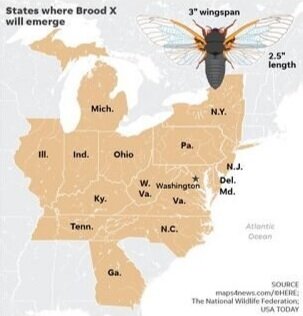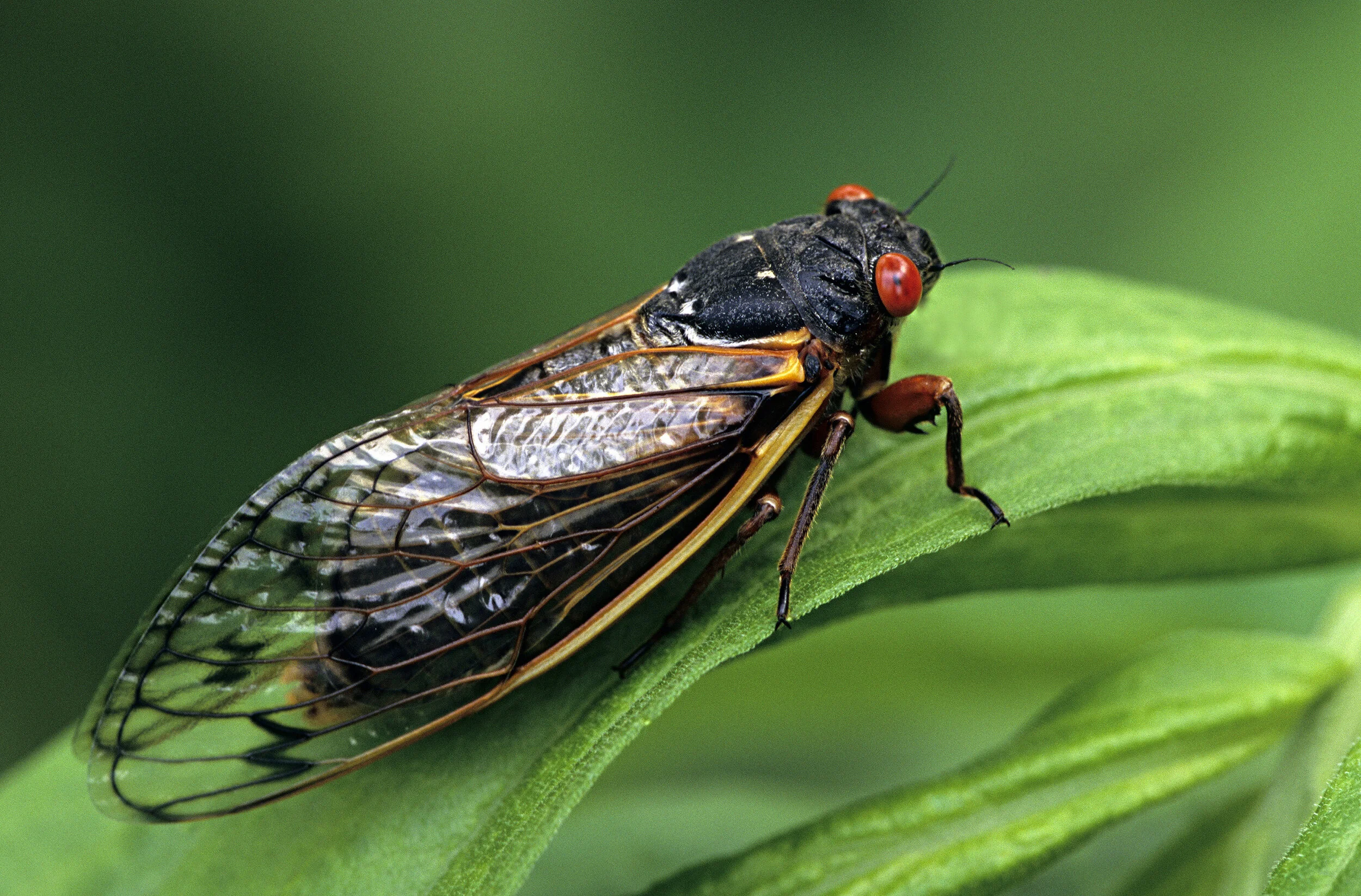Brood X Cicadas: The 17 Year Mystery
Picture of an adult cicada on a fallen tree. Adult cicadas have a small black body, orange legs, red eyes, and clear wings with veins.
Source:
https://www.delawarepublic.org/post/cicadas-101-learning-about-cicadas-first-state
If you live in the Mid-Atlantic area or even parts of the Midwest, you might have noticed some different bugs this summer! These cool creatures are cicadas. These bugs are a part of a group of insects that emerge periodically. The ones we are seeing this summer are a part of a family called the Brood X Cicadas. Even though there are some cicadas that come every year, and you might see other cicadas if you travel to different places, we only see these types of Brood X cicadas every 17 years in specific parts of the United States. That means no one has seen them since the year 2004! Even though they might look a little scary, they will not hurt humans. They cannot bite or sting, and they are not poisonous, so even if your pets decide to have a cicada snack they will be just fine. Cicadas help the entire ecosystem, because they serve as an extra food source. Certain animal species even reproduce at specific times in order to take advantage of the increased food supply.
A map of where you can expect to see the Brood X cicadas. This brood has the largest geographical range of cicadas in North America, and you can find them in the following states: Georgia, Michigan, Illinois, Maryland, Delaware, Pennsylvania, New York, New Jersey, Tennessee, Kentucky, North Carolina, and West Virginia!
Source:
https://www.vox.com/science-and-health/22362042/cicada-brood-x-map-2021
You may have also heard their unique noises - these are actually their mating calls. The calls can be as loud as a lawn mower or a garbage disposal! Males make the calls using muscles in their abdomen to attract females, and females use their wings to respond. The males and females have to be able to communicate with each other in order to reproduce. This is really important, because the Brood X cicadas come every 17 years so that they can reproduce above ground. They only live for a few weeks; which means they will all be gone by mid-July. After the males and females mate, the females lay eggs in tree bark. It takes about 6-10 weeks for the eggs to hatch and then the baby cicadas go underground. While they are living underground, they get their nutrients from the soil for the next 17 years.
You might be wondering how the cicadas could possibly know that 17 years has passed, especially if they are living underground. Every 17 years, when the soil is warm enough, baby cicadas (called nymphs) that have been living emerge as a group by crawling up through the soil. We don’t really know exactly how they can figure out how much time has passed, but it is possible they can keep track of the seasons with an internal clock. Another question is why would they only come every 17 years? Some scientists think that they come every 17 years so that there are so many cicadas available for predators to eat that they can’t possibly eat them all, and the surviving cicadas can reproduce. It is also possible that at these times some of their predators (reptiles, birds, squirrels, rabbits, and many more) are still young and will not be able to eat all of them, since adult animals need more food! Other scientists believe that emerging every 17 years is a strategy to make sure that they won’t emerge at the same time as other cicadas. This way, they won’t breed with cicadas outside of their brood. This would ensure that there is no cross-mating between different kinds of broods, which allows them to keep all their traits across generations. Scientists are still trying to figure this out, but it can be difficult since we don’t see them very often. Even though they might look a little different, if you have a chance, stop and check out a cicada! You won’t see these guys again until 2038!
References:
Landau, D. (2021, March 22). Embracing the Brood X Cicada Emergence. The Nature Conservancy.https://www.nature.org/en-us/get-involved/how-to-help/animals-we-protect/what-to-know-about-brood-x-cicadas/.
Resnick, B. (2021, April 1). Where billions of cicadas will emerge this spring (and over the next decade), in one map. Vox. https://www.vox.com/science-and-health/22362042/cicada-brood-x-map-2021.
Sulleyman, A. (2021, March 23). What cicadas look like, eat, and why they stay underground for years ahead of 2021 season. Newsweek. https://www.newsweek.com/what-cicadas-look-like-eat-why-they-stay-underground-years-ahead-2021-season-1578152.
































